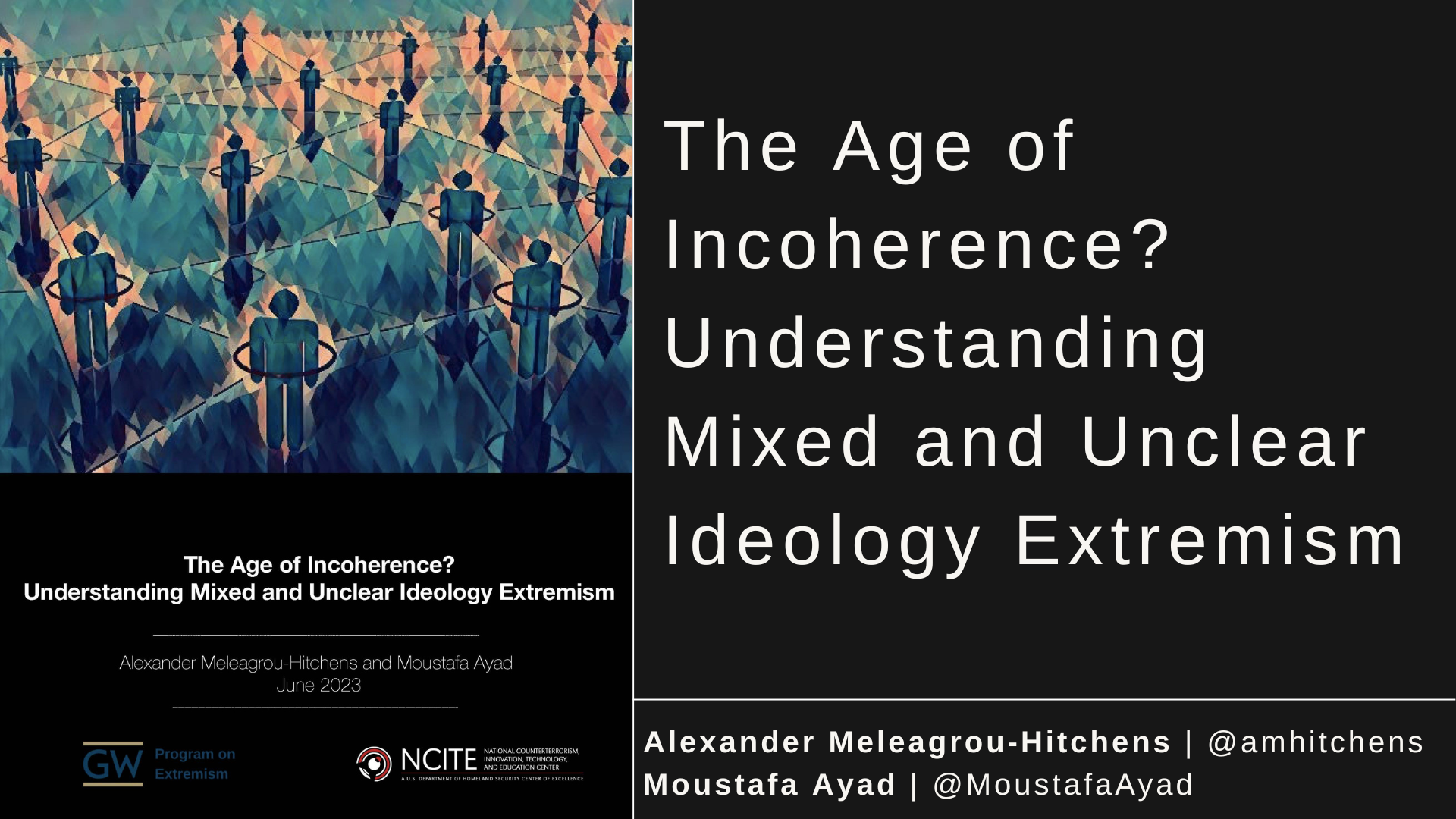Understanding Mixed Ideology Extremism

On September 19, 2023, the Program on Extremism at The George Washington University hosted a virtual event to discuss the recent Program study, The Age of Incoherence? Understanding Mixed and Unclear Ideology Extremism, which covers the authors' research on some of the ways this phenomenon has manifested and how it can be understood in the context of the wider extremism landscape in America.
This panel was moderated by Program Research Director and report co-author Alexander Meleagrou-Hitchens and included insights from:
- Moustafa Ayad, report co-author and Executive Director for Africa, Middle East and Asia at the Institute for Strategic Dialogue
- Meghan Conroy, US Research Fellow at the Atlantic Council's Digital Forensic Research Lab (DFRLab)
Alexander Meleagrou-Hitchens opened the panel by discussing the emerging popularity of the term “mixed ideology extremism.” In 2019, the Federal Bureau of Investigation (FBI) issued an intelligence bulletin that included one of the first official acknowledgments of what they and other similar agencies in the West identified as an emerging violent extremist threat. It warned that “anti-government, identity-based, and fringe political conspiracy theories” were playing an increasing role in motivating domestic extremists to commit criminal, sometimes violent, acts. Since then, officials have noted the emergence of individuals acting on the basis of “salad bar ideology” extremism, a term used in 2020 by FBI Director Christopher Wray to describe the nature of some of the recent violent extremist threats. Meleagrou-Hitchens and co-author Moustafa Ayad sought to offer conceptual clarity of what this means in their most recent report on the topic. Specifically, the report focuses on the evolving overlap between right-wing extremism and Islamist ideological extremism, and “conspiracy extremism.” Meleagrou-Hitchens noted that conspiracy extremism is both novel and on the increase, with popular narratives including Satanic threats to children, the 2020 ‘stolen’ election, and COVID/vaccinations driving recent attacks.
Moustafa Ayad followed with remarks on the shifting extremist landscape, including the evolution of online content shaping both mainstream and fringe communities. Ayad classified “meme” content from social media and messaging platforms according to a framework based on “idiosyncratic terrorism” developed by Jesse Norris. Idiosyncratic terrorism includes four dimensions: ideologies, tactics, strategic thinking, and motives. Ayad argued that missing from the discussion is how content plays a role in defining, or creating, new idiosyncratic ideologies. He identified a constantly evolving overlap between extreme right-wing and various iterations of extremist Islamist ideologies. These idiosyncratic overlaps included the appropriation of chan culture aesthetics and language, ideological doctrines, and definitions of in-group/out-groups across ideologically disparate groups such as racially/ethnically motivated violent extremists (RMVEs) and Islamist extremists.
Meghan Conroy rounded out the panelists’ remarks with her discussion of mobilizing concepts. Conroy argued that the nature of mixed ideology is not random, but is based on reactionary and anti-liberal politics. She identifies several mobilizing concepts for these reactionaries including: the preservation of power, the view of outgroup success as a threat, and narratives rooted in fear, anger, and victimhood. The ultimate mobilization narrative is weaponized victimhood, which is used to justify the violent “self-defense.” Finally, Conroy discussed the trend of tactical convergence where groups, while still motivated by their own ideological priorities, are increasingly adopting the tactics of others. For example, groups adopting Proud Boys’ chapter-based tactics, Proud Boys adopting hate groups’ mainstreamist tactics, and January 6th defenders adopting the criminal defense tactics used by Sovereign CItizens. Therefore, Conroy argued that measuring “impact over intent” and “mobilizing concepts over intent” is the best approach for preventing violence.
Meleagrou-Hitchens concluded the panel with a discussion on the importance of government transparency in overcoming mistrust and addressing conspiracy theories without playing into pre-existing conspiratorial beliefs. Ayad remarked on the effectiveness of captivating storytelling, likening it to the conspiracy of alien architects of Egyptian pyramids, arguing “pre-bunking” is necessary in weakening the power of these conspiratorial stories. Conroy wrapped up the panel by addressing how practitioners can anticipate when online discussions will move to offline violence. From her own research, she has found specificity as an indicator of intentionality and cited a field guide published by the Institute for Strategic Dialogue as an excellent resource for this kind of forecasting. However, individuals seeking to commit mass attacks often do not indicate their intent beforehand, making it all the more difficult to detect and intervene.


